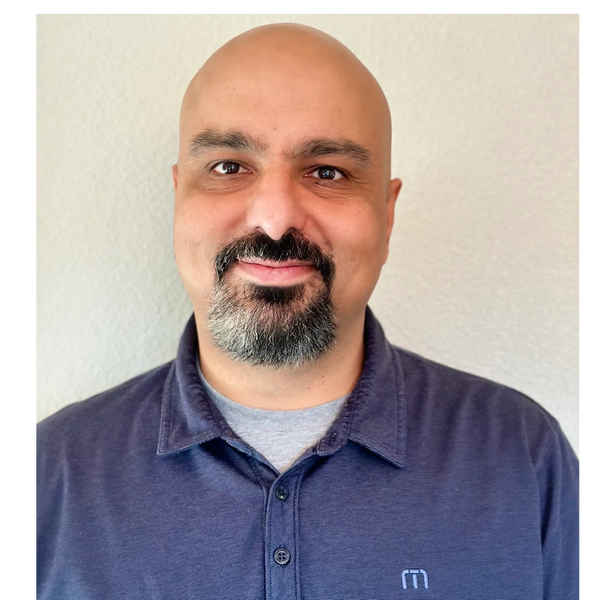About

Patrick Satarzadeh is a highly experienced systems engineer with a strong background in digital signal processing algorithm development as well as expertise in analog/photonic circuit modeling and calibration. He has held senior positions at leading technology companies such as Lumentum, Tektronix, Xilinx and Texas Instruments where he has made significant contributions to the development of cutting-edge technologies.
Previously, Patrick co-founded Areanna AI, a company that pioneered the development of in-memory compute engines for next-generation AI accelerators. The company's successful chip tapeout led to an early acquisition, validating its innovative approach and market potential
Throughout his career, Patrick has demonstrated a strong ability to design and implement complex digital and analog algorithms, particularly in the areas of ADCs, DACs, and SerDes. He is also proficient in numerical modeling and development of signal processing and communication systems using MATLAB/Simulink/Python.
Patrick's technical skills extend to circuit design in Spice and Cadence, as well as AI algorithm development using open-source frameworks like TensorFlow and TensorFlow Lite. A member of IEEE/Optica and a frequent reviewer for conference and journal papers, Patrick actively contributes to the advancement of his field. He closely follows industry developments in PCIe, UCIe, Ethernet, and OIF
Selected Publications
Digital Correction of Time Interleaved DAC Mismatches
A 20mW 61dB SNDR (60MHz BW) 1b 3rd-order continuous-time delta-sigma modulator clocked at 6GHz in 45
A 20mW 61dB SNDR (60MHz BW) 1b 3rd-order continuous-time delta-sigma modulator clocked at 6GHz in 45
A 20mW 61dB SNDR (60MHz BW) 1b 3rd-order continuous-time delta-sigma modulator clocked at 6GHz in 45
A 20mW 61dB SNDR (60MHz BW) 1b 3rd-order continuous-time delta-sigma modulator clocked at 6GHz in 45
A 20mW 61dB SNDR (60MHz BW) 1b 3rd-order continuous-time delta-sigma modulator clocked at 6GHz in 45
Equalizer Design and Performance Trade-Offs in ADC-Based Serial Links
A 20mW 61dB SNDR (60MHz BW) 1b 3rd-order continuous-time delta-sigma modulator clocked at 6GHz in 45
A 5 Gb/s Link With Matched Source Synchronous and Common-Mode Clocking Techniques
A 5 Gb/s Link With Matched Source Synchronous and Common-Mode Clocking Techniques
A parametric polyphase domain approach to blind calibration of timing mismatches for M-channel time-
A 5 Gb/s Link With Matched Source Synchronous and Common-Mode Clocking Techniques
A parametric polyphase domain approach to blind calibration of timing mismatches for M-channel time-
A parametric polyphase domain approach to blind calibration of timing mismatches for M-channel time-
A parametric polyphase domain approach to blind calibration of timing mismatches for M-channel time-
Digital Calibration of a Nonlinear S/H
A parametric polyphase domain approach to blind calibration of timing mismatches for M-channel time-
A parametric polyphase domain approach to blind calibration of timing mismatches for M-channel time-
Adaptive Semi-blind Calibration of Bandwidth Mismatch for Two-Channel Time-Interleaved ADCs
Adaptive Semi-blind Calibration of Bandwidth Mismatch for Two-Channel Time-Interleaved ADCs
Adaptive Semi-blind Calibration of Bandwidth Mismatch for Two-Channel Time-Interleaved ADCs
Digital calibration Methods for Sample-and-Hold Circuits
Adaptive Semi-blind Calibration of Bandwidth Mismatch for Two-Channel Time-Interleaved ADCs
Adaptive Semi-blind Calibration of Bandwidth Mismatch for Two-Channel Time-Interleaved ADCs
Physical and Filter Pinna Models Based on Anthropometry
Adaptive Semi-blind Calibration of Bandwidth Mismatch for Two-Channel Time-Interleaved ADCs
Physical and Filter Pinna Models Based on Anthropometry
Featured Patents
Integrated Communication Link Testing
Digital signal processing waveform synthesis for fixed sample rate signal sources
Real-time jitter impairment insertion for signal sources
Real-time jitter impairment insertion for signal sources
Digital signal processing waveform synthesis for fixed sample rate signal sources
Real-time jitter impairment insertion for signal sources
Digital signal processing waveform synthesis for fixed sample rate signal sources
Digital signal processing waveform synthesis for fixed sample rate signal sources
Digital signal processing waveform synthesis for fixed sample rate signal sources
Noise reduction in digitizing systems
Circuits for and methods of receiving data in an integrated circuit
Noise reduction in digitizing systems
Signal loss detector
Circuits for and methods of receiving data in an integrated circuit
Noise reduction in digitizing systems
Circuits for and methods of receiving data in an integrated circuit
Circuits for and methods of receiving data in an integrated circuit
Circuits for and methods of receiving data in an integrated circuit
Channel adaptive receiver switchable from a digital-based receiver mode to an analog-based receiver
Channel adaptive receiver switchable from a digital-based receiver mode to an analog-based receiver
Channel adaptive receiver switchable from a digital-based receiver mode to an analog-based receiver
Excess loop delay compensation for a continuous time sigma delta modulator
Channel adaptive receiver switchable from a digital-based receiver mode to an analog-based receiver
Channel adaptive receiver switchable from a digital-based receiver mode to an analog-based receiver
Method and apparatus for performing data conversion with non-uniform quantization
Channel adaptive receiver switchable from a digital-based receiver mode to an analog-based receiver
Method and apparatus for performing data conversion with non-uniform quantization
Pipelined ADC inter-stage error calibration
Method for calibrating a pipelined continuous-time sigma delta modulator
Compressive sensing analog-to-digital converters
Compressive sensing analog-to-digital converters
Method for calibrating a pipelined continuous-time sigma delta modulator
Compressive sensing analog-to-digital converters
Method for calibrating a pipelined continuous-time sigma delta modulator
Method for calibrating a pipelined continuous-time sigma delta modulator
Method for calibrating a pipelined continuous-time sigma delta modulator
PatrickSatarzadeh
Copyright © 2024 PatrickSatarzadeh - All Rights Reserved.
Powered by GoDaddy


